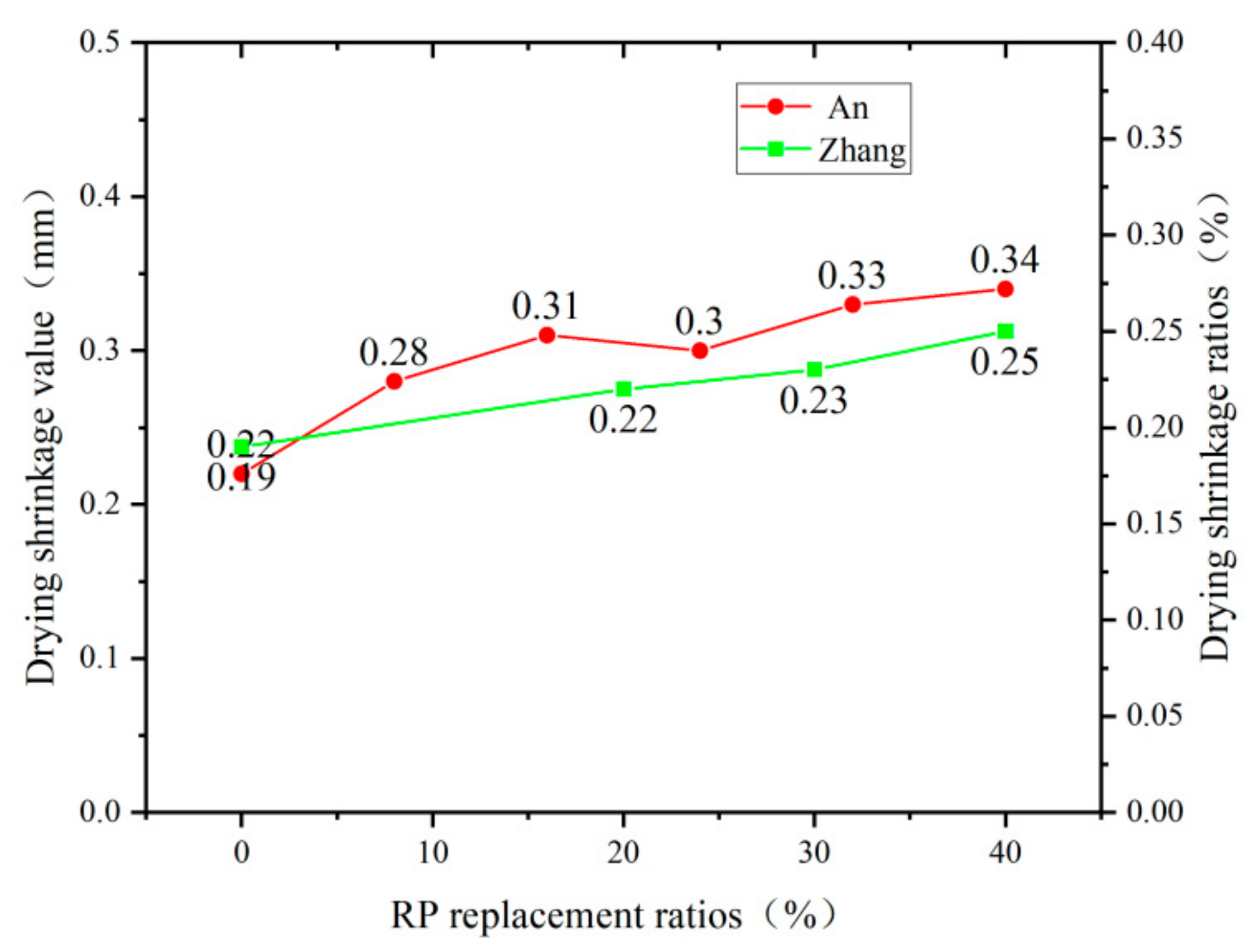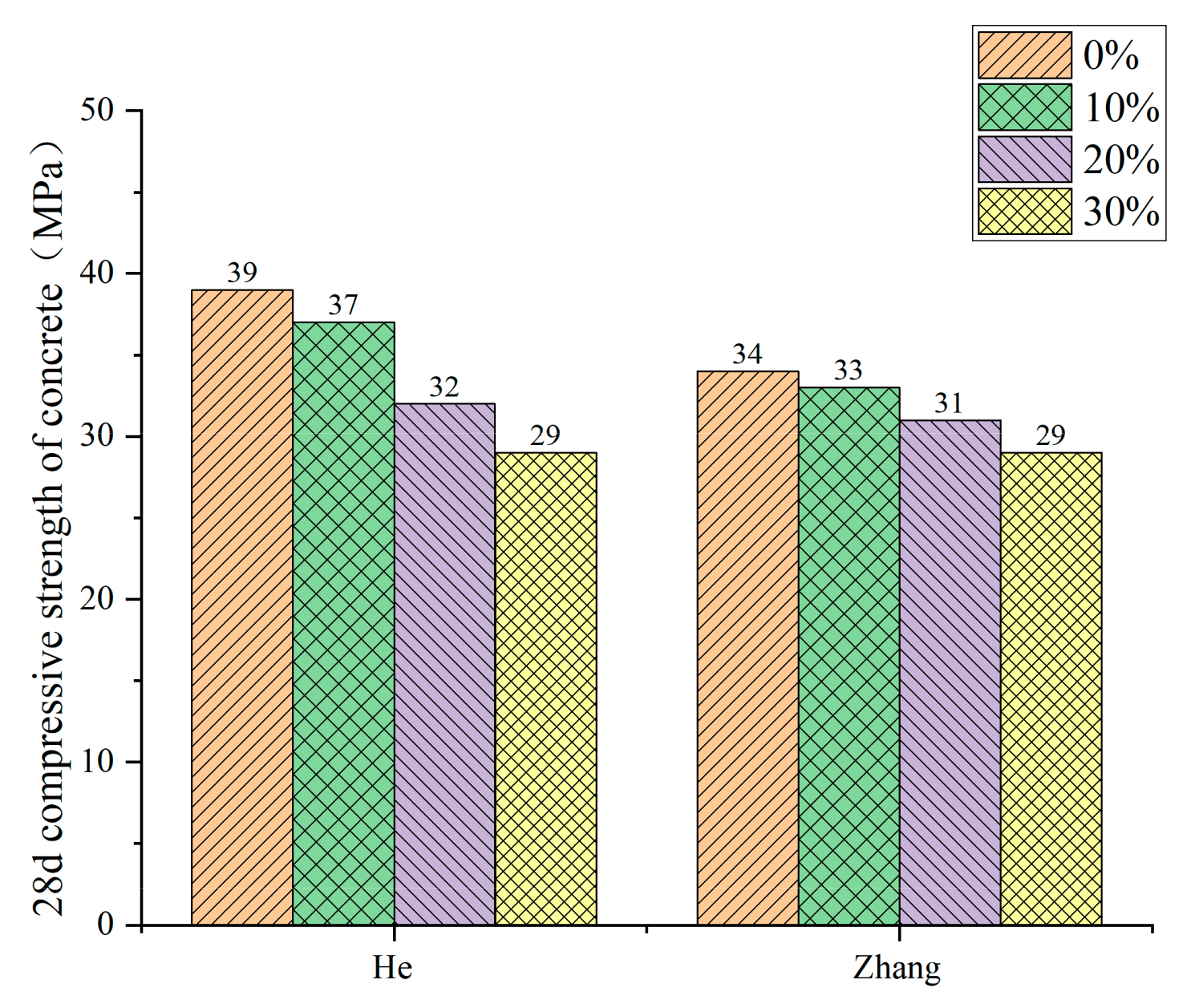Performance of Building Solid Waste Powder in Cement Cementitious Material: A Review
Abstract
:1. Introduction
2. Source and Preparation of RP
2.1. Source of RP
2.2. Preparation of RP
3. Fundamental Properties of RP
3.1. Physical Properties of RP
3.2. Chemical Composition of RP
3.3. Microscopic Analysis of RP
3.4. Activity Index
4. Early Properties of RP Cement-Based Materials
4.1. Setting Time
4.2. Flowability
4.3. Drying Shrinkage
5. Mechanical Properties of Cement-Based Materials with RP
5.1. Compressive Strength
5.2. Flexural Strength
5.3. Splitting Tensile Strength
6. Linear Regression Analysis
6.1. Matrix Dimensionless Processing
6.2. Calculate the Relational Coefficient of Each Indicator
6.3. Calculate the Grey Relational Degree
7. RP Activation Methods
- (1)
- Increase the fineness of the RP. Increasing the fineness of the RP can increase the specific surface area of the RP, convert the stable α-SiO2 into amorphous SiO2, and then improve the activity of the RP [96,98]. Li et al. [99] believed that the particle size of the RP should be controlled to be less than 75 μm and that the finer the RP, the higher the activity. RCP powder with a particle size smaller than 75 μm promotes the formation of single-calcium carbonate. As the RP particle size decreases, the surface binding energy decreases, the Si-O and Al-O chemical-bond-breaking energy decreases, and the internal structure reorganizes, making it easier to generate cementitious substances. However, the RP should not be too fine, as the material will agglomerate, which will reduce the compactness of void filling and reduce the strength of the specimen [96,97,100].
- (2)
- RP heat treatment. Florea [101] found that the 28 d compressive strength of RP mortar increased by 14.7% and 20.1% after high-temperature treatment at 500 °C and 800 °C, respectively. Kang [102] found that the excitation effect after treatment at 800 °C was better than that after treatment at 600 °C. He attributed this to the fact that the high temperature caused an activation effect of the RP similar to that of blast furnace slag. The RP produced a phase similar to that of calcium silicate in cement at a high temperature of 800 °C. Lv [103] measured the RP activity at 200 °C, 400 °C, 600 °C, and 800 °C and found that the RP activity first increased and then decreased with the increase in temperature, and the optimal thermal activation temperature was 600 °C. The cementitious material will coagulate and separate under high-temperature conditions. When the temperature is above 500 °C, CaCO3 will decompose into CaO. The decomposition of C-S-H and Ca(OH)2 in the cementitious material forms CaO, which has a high specific surface area and high activity. Generally speaking, the higher the CaO content in the RP, the greater the activity. However, scholars’ optimal heat treatment temperatures are inconsistent and are related to the source and composition of the RP used in the experiment.
- (3)
- Alkali-activated treatment. The RP composition of calcium carbonate, calcium silicate, and silica was measured by EDS, providing a solid basis for alkali chemical excitation [58]. Dong [104] found that when 0% to 4.8% NaOH was added, the specimen strength increased with NaOH dosing and gradually decreased when it exceeded 4.8%. The addition of RP reduces the alkalinity of the concrete, and the addition of an alkali exciter can improve the activity of the RP. It can be explained that the addition of an alkali activator can promote the formation of C-S-H in concrete and make the microstructure of concrete denser. Liu [105] showed that the excitants Na2SO4, NaOH, Ca(OH)2, and NaHCO3 had specific active excitation effects on the RP through net cement paste specimen tests and scanning electron microscope observations. The optimal excitation doses were 3%, 3%, 2.5%, and 2.5%, respectively.
- (4)
- CO2 treatment. Since the RP still has a large amount of calcium oxide, researchers have used CO2 to treat it RP. After carbonization, the strength of the cementitious material is higher than before carbonization. Maintenance with CO2 can improve the performance of the RP products. Li [106] treated the RP with a low concentration of CO2, which enhanced not only the physicochemical properties of the RP but also improved the activity of the RP. Cheng [107] found that the net cement paste mixed with carbonized cement paste powder had higher flow and compressive strength than that mixed with uncarbonized powder. This is because the addition of carbonized RP increases the calcium carbonate content in the system. The calcium carbonate reacts with the aluminum phase in the cement to form a hydrated calcium carbonate aluminate. This promotes the stability of ettringite and increases the volume of hydration products. The accelerated carbonation curing of concrete and mortar with CO2 allows them to gain strength quickly and have good mechanical properties and durability [108].
- (5)
- Double mixing. RCP, RBP, fly ash, slag, and silica fume blending can improve the composition and promote the volcanic ash reaction of cementitious materials. It is conducive to improving the long-term strength of the concrete and can improve the workability of concrete. Xiao [109] showed that when RP was compounded with mineral powder, the early and late strengths were higher than those of single blending, and the late strength was more significantly improved later. This is because the RP and mineral powder produce a specific micro-aggregate effect. The mineral powder undergoes a secondary hydration reaction in the early and late stages under alkali substances, thus improving the concrete’s strength. Bai [110] studied the effect of compounding on the anti-carbonation performance of concrete. The compounding of RP, fly ash, and silica fume can significantly improve the anti-carbonation performance of concrete. The anti-carbonation performance of concrete is optimal when RP:(fly ash + silica fume) = 7:3. There are five ways to activate the RP.
8. Future Prospects of RP
- (1)
- Regarding construction waste recycling, China has been vigorously promoting waste classification. However, the mechanism of waste concrete recycling is not perfect. At present, all waste is recycled together. The lack of inspection, other classification processes, and construction waste recycling negatively impact efficiency. China should establish construction waste recycling norms and further improve awareness of construction waste classification and recycling.
- (2)
- At present, scholars in China and abroad mainly focus on studying the mechanical properties and workability of RP on cement-based materials but focus less on the durability of cement-based materials, especially corrosion resistance, and the need to strengthen the research on durability in the future.
- (3)
- Concerning the optimum dose of RP for cement-based materials, the optimum dose obtained varies due to different initial conditions. For example, the type of RP, the fineness of the RP, the method of RP excitation, and the dosing of exciter will affect the optimum dose of RP for cement-based materials. Therefore, further research by researchers is required to make it a complete system.
- (4)
- Regarding the activation method of RP, mechanical grinding, further research should be conducted to determine the optimal grinding time for different grinding machinery apparatuses and different types of RP. An industry standard must be developed and would be significant for reducing energy waste and for the industrial production of more efficient RP.
- (5)
- Regarding the activation method of alkaline excitation treatment of RP, domestic and foreign scholars currently use single-activator activation, and research on composite-activator activation of RP is relatively scarce. Therefore, domestic and foreign scholars should increase research in this area.
- (6)
- Scholars in China and abroad have concentrated on improving the mechanical strength of RP, and very few have studied the use of the low-strength properties of RP itself. For example, Xiao proposed to prepare low-strength foam recycled concrete from recycled raw materials and apply it to the material blocking system of the airport runway safety zone [111]. Scholars at home and abroad can also follow this idea to explore and study other uses of RP without deliberately pursuing high-strength and high-performance materials.
- (7)
- Most researchers use the cementitious properties of RP to prepare cementitious materials. However, the cementitious properties of RP are far less than those of cement. Therefore, the performance of the prepared cementitious materials is not satisfactory. For example, it is feasible to combine RP with organic polymer material polyurethane, use quartz sand as coarse aggregate, RP as fine aggregate, polyurethane as cementitious material, and prepare a new material—RP polyurethane composite material.
Author Contributions
Funding
Institutional Review Board Statement
Informed Consent Statement
Data Availability Statement
Conflicts of Interest
References
- Gu, J.T.; Chen, Y.; Su, J.; Zhao, G.; Fang, C. Design and practice of construction waste recycling production line. New Build. Mater. 2021, 48, 36–39. [Google Scholar]
- Buck, A.D. Recycled concrete as a source of aggregate. ACI Mater. J. 1977, 74, 212–219. [Google Scholar]
- Zhou, W.J.; Chen, J.L.; Lu, H.B.; Zhou, L.A. Study on Status and Development Trend of Disposal and Use of Domestic Construction Waste. China Resour. Compr. Util. 2009, 27, 22–24. [Google Scholar]
- Zhao, L. Study on Basic Properties and Application of Recycled Fine Powder from Construction Waste. Master’s Thesis, Beijing University of Civil Engineering Architecture, Beijing, China, 2019. [Google Scholar]
- Wu, B.Y.; Ding, L.; Zhang, A.S. Experimental Study on Early Strength of Concrete Pavement Brick Fabricated with Constructional Brick-Concrete Recycled Aggregate. Concrete 2021, 43, 108–112+126. [Google Scholar]
- Soni, N.; Shukla, D.K. Analytical study on mechanical properties of concrete containing crushed recycled coarse aggregate as an alternative of natural sand. Constr. Build. Mater. 2021, 266, 120595. [Google Scholar] [CrossRef]
- Contrafatto, L.; Cosenza, R.; Barbagallo, R.; Ognibene, S. Use of recycled aggregates in road sub-base construction and concrete manufacturing. Ann. Geophys. 2018, 61, SE223. [Google Scholar] [CrossRef] [Green Version]
- Li, H.; Wu, C.F.; Wan, S.; Zhang, J.S. Study on Performance of Construction Waste in Roadbed Backfill Materials. J. China Foreign Highw. 2019, 39, 253–256. [Google Scholar]
- Schoon, J.; De Buysser, K.; Van Driessche, I.; De Belie, N. Fines extracted from recycled concrete as alternative raw material for Portland cement clinker production. Cem. Concr. Compos. 2015, 58, 70–80. [Google Scholar] [CrossRef]
- Park, D.-C.; Kwon, E.-H.; Ahn, J.-C. Analysis on Calcination of Cementitious Powder of Waste Concrete for Raw Cement. J. Korea Inst. Build. Constr. 2014, 14, 54–60. [Google Scholar] [CrossRef] [Green Version]
- Tikkanen, J.; Cwirzen, A.; Penttala, V. Freeze–thaw resistance of normal strength powder concretes. Mag. Concr. Res. 2015, 67, 71–81. [Google Scholar] [CrossRef]
- Moon, H.-Y.; Jung, H.-S.; Kim, J.-P. Diffusion of Chloride Ions in Limestone Powder Concrete. J. For. Res. 2004, 16, 21–24. [Google Scholar] [CrossRef] [Green Version]
- Singh, M.; Srivastava, A.; Bhunia, D. Analytical and Experimental Investigations on Using Waste Marble Powder in Concrete. J. Mater. Civ. Eng. 2019, 31, 04019011. [Google Scholar] [CrossRef]
- Kim, Y.-J. Quality properties of self-consolidating concrete mixed with waste concrete powder. Constr. Build. Mater. 2017, 135, 177–185. [Google Scholar] [CrossRef]
- Rocha, S.; Sousa-Coutinho, J. Construction and demolition waste as partial cement replacement. Adv. Cem. Res. 2019, 31, 411–422. [Google Scholar] [CrossRef]
- Santhosh, A.M.; Thomas, A. Experimental studies on brick powder replaced concrete exposed to elevated temperature. Lecture Notes in Civil Engineering. In Proceedings of the 3rd National Conference on Structural Engineering and Construction Management (SECON’19), Angamaly, India, 15–16 May 2019; pp. 41–52. [Google Scholar]
- Lam, N.N. Heat Resistant Mortar Using Portland Cement and Waste Clay Bricks. In CIGOS 2019, Innovation for Sustainable Infrastructure; Lecture Notes in Civil Engineering; Springer: Singapore, 2020; pp. 549–554. [Google Scholar]
- Mao, X.Q.; Wang, X.G.; Zhao, T.J. High Performance and No Pollution Concrete. Fly Ash Compr. Util. 2003, 17, 46–49. [Google Scholar]
- Yu, X.-X.; Li, R.-Y.; Dong, X.; Li, G.; Zhang, S. Effect of Mechanical Force Grinding on the Properties of Recycled Powder. J. Synth. Cryst. 2017, 46, 688–692. [Google Scholar]
- Zhang, P.; Gulong, L.; Li, K.; Wang, Z.M. Study on Frost Resistance and Sulfate Resistance of Concrete with Recycled Fine Powder. China Concr. Cem. Prod. 2020, 3, 27–30. [Google Scholar]
- Li, K.L.; Teng, Y.H.; Xu, F.; Wang, K.R.; Cheng, C.H.; Xue, C.G. Preparation and Compatibility of Ultrafine Powder from Coal Gasification Fine Slag. China Powder Sci. Technol. 2022, 28, 100–108. [Google Scholar]
- Liu, Q.; Li, B.; Xiao, J.; Singh, A. Utilization potential of aerated concrete block powder and clay brick powder from C&D waste. Constr. Build. Mater. 2020, 238, 117721. [Google Scholar]
- Liu, C.; Lu, W.M.; Wu, Z.G.; Wang, T.; Sun, H.F. Experimental Study on Properties of Geopolymer Stabilized Macadam Base Materials Prepared by Recycled Micropowder. New Build. Mater. 2020, 47, 41–45. [Google Scholar]
- Huang, H.; Wang, W.J. Experimental Study on Sludge Solidified by Recycled Micro Powder of Waste Concrete and Cement. Low Temp. Archit. Technol. 2022, 44, 77–81. [Google Scholar]
- Fu, Y.; Xue, C.; He, J.; Liu, Y.; Zhu, X. Study on the Particle Characteristics of Recycled Concrete Powder and the Performance of Mortar. Mater. Rep. 2022, 36, 98–103. [Google Scholar]
- Kang, X.M. Study on the Influence of the Particle Size Distribution of Recycled Concrete Powder on the Mechanical Properties and Microstructure of Recycled Mortar. Master’s Thesis, Qinghai University, Xining, China, 2019. [Google Scholar]
- Zhao, G.Y. Basic Properties and Activation Technology of the Recycled Concrete Powder. Master’s Thesis, China University of Mining and Technology, Xuzhou, China, 2014. [Google Scholar]
- Li, J.J. Exploring the basic properties of recycled construction waste micronized powder and its application. Constr. Mater. Decor. 2020, 16, 46–47. [Google Scholar]
- Lu, Z.C. Research on Effect of Waste Concrete Dust on Performance of Mortar and Pervious Concrete. Master’s Thesis, Guangdong University of Technology, Guangzhou, China, 2020. [Google Scholar]
- Lin, Z.H. Experimental Study on Performance of Mortar and Concrete Incorporating Recycled Clay Brick Dust. Master’s Thesis, Guangdong University of Technology, Guangzhou, China, 2019. [Google Scholar]
- Fediuk, R.S.; Ibragimov, R.A.; Lesovik, V.S.; Pak, A.A.; Krylov, V.V.; Poleschuk, M.M.; Stoyushko, N.Y.; Gladkova, N.A. Processing equipment for grinding of building powders. IOP Conf. Ser. Mater. Sci. Eng. 2018, 327, 042029. [Google Scholar] [CrossRef]
- Wang, H.; Xia, Y. Influence of recycled of Fine Powder on shrinkage Cracking of Concrete. Ind. Constr. 2016, 46, 122–125+104. [Google Scholar]
- Yu, J.; Tian, L.; Wang, Y.; Liu. K. Mechanical Property of Recycled Micro-powder Cementitious Composites with ultra-high Ductility. Mater. Rep. 2019, 33, 1328–1334. [Google Scholar]
- Li, Y.; Kang, X. Effect of Physical Excitation on the Properties of Recycled Fine Powder. IOP Conf. Ser. Earth Environ. Sci. 2019, 219, 012025. [Google Scholar] [CrossRef]
- Chen, X.; Li, Y.; Zhuang, P.Y. Experimental Study on Cementitious Properties of Recycled Fine Powder from Waste Concrete. China Concr. Cem. Prod. 2019, 46, 96–100. [Google Scholar]
- Jiao, X.F. Influence of Recycled Construction Waste Powder on the Strength of Cement Mortar. Res. Appl. Build. Mater. 2021, 42, 4–7. [Google Scholar]
- Fan, W.L.; Chen, S.P.; Chen, S.K.; Bie, Y.J.; Ding, Z.L. Study on the Influence of Recycled Fine Powder Content on the Performance of Recycled Pervious concrete. China Concr. Cem. Prod. 2020, 47, 86–90. [Google Scholar]
- Feng, Y.; Wang, S.Y.; Shi, Y.X. Effect of recycled concrete powder on recycled aggregate permeable concrete. Henan Water Resour. South-North Water Divers. 2019, 48, 78–81. [Google Scholar]
- Zhou, C.S.; Ji, H.B.; Zhao, L.Y. Application and Research Progress of Recycled micro-powders in Cement-based Materials. Bull. Chin. Ceram. Soc. 2019, 38, 2456–2463. [Google Scholar]
- Gao, S.; Li, Q.; Li, N.; Jin, Z. Research on Super Dense Recycled Mortar Preparation Based on Densified Parking Theory. J. Build. Struct. 2021, 42, 466–472. [Google Scholar]
- Xue, Z.L. Study on the Influence on the Performance of Pervious Concrete and Recycled Aggregate. Master’s Thesis, North China University of Water Resources and Electric power, Zhengzhou, China, 2018. [Google Scholar]
- Li, X.L.; Wu, R.; Guo, Q. Experimental Study on the Axial Compression Mechanical Property of recycled micro-powder Concrete. J. Shandong Jianzhu Univ. 2021, 36, 11–19. [Google Scholar]
- An, X.J.; Ren, Y.L.; Huang, L.J. Study on the Effect of Recycled powder on the Mechanical and Thermal Conductivity Properties of Foamed Concrete. Contemp. Chem. Ind. 2021, 50, 1522–1525. [Google Scholar]
- Liu, L.; Liu, S.Y.; Li, T.Y.; Liu, Y.Q.; Yu, J.Y.; Li, S.J.; Gao, D.X. Effect of recycled fine powder on early-age properties and rheological of cement paste. Concrete 2021, 43, 114–117. [Google Scholar]
- Tang, Q.; Ma, Z.; Wu, H.; Wang, W. The utilization of eco-friendly recycled powder from concrete and brick waste in new concrete: A critical review. Cem. Concr. Compos. 2020, 114, 103807. [Google Scholar] [CrossRef]
- Feng, Y.C. Study on the Properties of Recycled Powder for Foam Concrete. Master’s Thesis, Ningxia University, Yinchuan, China, 2020. [Google Scholar]
- Zhou, W.J.; Ji, Z.Y.; Zhao, L.; He, X.D. Basic Performance of Construction Waste Recycled Powder and Its influence on Properties of Cement Mortar. China Concr. Cem. Prod. 2019, 46, 93–96. [Google Scholar]
- Du, M.F.; Zhao, Y.Q.; Xiang, Y.X.; Shang, J.J. Effect of Activated Recycled Brick Powder on Mechanical Properties of UHPC. China Concr. Cem. Prod. 2021, 48, 91–94. [Google Scholar]
- Jin, B.; Wang, X.; Yang, L.S.; Xu, Z.Y.; Zhang, J.W.; Li, Z.X.; Li, M.L. Study of the Autoclaved Brick Preparation by Using Constriction Waste, Dry Desulphurized Ash and Slag. Non-Met. Mines 2020, 43, 44–46. [Google Scholar]
- Yao, K.Y. Research on Application of Waste Concrete in Cement Stabilized Crushed Stone Base and Subbase. Master’s Thesis, Shandong University, Jinan, China, 2021. [Google Scholar]
- Zhang, J.; Liu, H.M.; Ai, W.B.; Cheng, Y.F.; Wang, X.X.; Xu, Q. Study on the Influence of Different Activators on the Strength of Waste Concrete Recycled Brick. New Build. Mater. 2020, 47, 91–95. [Google Scholar]
- Chen, X. Experimental Study on Waste Concrete Recycled Micro-Powder as Supplementary Cementitious Material. Master’s Thesis, Qinghai University, Xining, China, 2021. [Google Scholar]
- Lu, X.R. Research on Flexural Performance of High Ductility Recycled Powder Concrete (HDRPC) Beam. Master’s Thesis, Shandong University of Construction, Jinan, China, 2021. [Google Scholar]
- Li, S.J.; Zhao, X.L.; Li, Q.Y. Experimental Study on Fluidity of Recycled Fine Powder. Concrete 2020, 42, 84–87. [Google Scholar]
- Zhao, S.Y.; Li, Y.; Kang, X.M.; Fan, Y.H. Experimental Study on Frost Resistance of Recycled Fine Powder Concrete. Ind. Constr. 2020, 50, 96+112–118. [Google Scholar]
- Fan, Y.H. Study on Carbonization Resistance and Impermeability of Recycled Micronized Concrete. Master’s Thesis, Qinghai University, Xining, China, 2020. [Google Scholar]
- Fan, Y.H.; Li, Y.; Kang, X.M. Effect of regenerated powder and fly ash on mechanical properties and micro structure of mortar. J. Bull. Chin. Ceram. Soc. 2019, 38, 537–542. [Google Scholar]
- Chen, S.D. Effect of Recycled Micro Powder on Compressive Strength of Ultra-high Performance Concrete. J. Munic. Technol. 2020, 38, 271–273. [Google Scholar]
- Yu, X.-X. Study on Activation and Function of Recycled Powder of Waste Concrete. Master’s Thesis, Kunming University of Science and Technology, Yunnan, China, 2017. [Google Scholar]
- Rangel, C.S.; Amario, M.; Pepe, M.; Martinelli, E.; Filho, R.D.T. Durability of Structural Recycled Aggregate Concrete Subjected to Freeze-Thaw Cycles. Sustainability 2020, 12, 6475. [Google Scholar] [CrossRef]
- Zhang, L.J. Hydration Property on Recycled Powder-Cement Composite Cementitious Material. China Concr. Cem. Prod. 2013, 40, 14–17. [Google Scholar]
- Zhu, Y.L.; Zou, W.X.; Yin, M.; Zhu, J. Influence of Recycled Powder and Slag on Cement Performance. J. Guangxi Univ. (Nat. Sci. Ed.) 2016, 41, 1214–1219. [Google Scholar]
- Zhang, X.Q. Experimental Study on the Utilization of Renewable Micronized. Master’s Thesis, Qingdao University of Technology, Qingdao, China, 2015. [Google Scholar]
- Gao, S.B. Full-Component of Waste Cement and Utilization of Recycled Concrete. Master’s Thesis, China University of Mining and Technology, Xuzhou, China, 2019. [Google Scholar]
- Xie, H.Z.; Li, G.; Liu, F. Influence of Recycled Fine Powder on Performance of Cement Mortar and concrete. In Proceedings of the 21st National Symposium on Modern Structural Engineering, Shijiazhuang, China, 23 July 2021; pp. 356–361. [Google Scholar]
- Guo, Y.H. Study on the Graded Resource Utilization Method of Waste Aerated Concrete. Master’s Thesis, Harbin Institute of Technology, Harbin, China, 2021. [Google Scholar]
- Jiang, H.G.; Li, F.H. Effect of Recycled Fine Powder Content on Mechanical Properties of UHPC. New Build. Mater. 2020, 47, 79–81+133. [Google Scholar]
- Zhang, X.M.; Huang, P.Z.; Cui, Q.Y. Study on Performance of Foam Concrete with Recycled Micro Powder from Construction. China Concr. Cem. Prod. 2020, 47, 96–98. [Google Scholar]
- Qian, D.; Yu, R.; Shui, Z.; Sun, Y.; Jiang, C.; Zhou, F.; Ding, M.; Tong, X.; He, Y. A novel development of green ultra-high performance concrete (UHPC) based on appropriate application of recycled cementitious material. J. Clean. Prod. 2020, 261, 121231. [Google Scholar] [CrossRef]
- Gao, Z.L.; Liu, X.Y.; Zuo, J.Q.; Dou, L.Q.; Wang, X.R. Study on Shrinkage Performance of Concrete Containing Re-Production Powder Using Ring Test. Fly Ash Compr. Util. 2012, 26, 6–10. [Google Scholar]
- Liu, M. Properties of the Foam Concrete Containing Recycled Powder Derived from Construction and Demolition Waste. Master’s Thesis, Yangzhou University, Yangzhou, China, 2021. [Google Scholar]
- Qu, Y.Y. Study on Properties of Recycled Concrete Foamed Concrete with Construction Waste. Master’s Thesis, Shenzhen University, Shenzhen, China, 2019. [Google Scholar]
- Qiang, C. Study on Properties of Recycled Concrete Prepared with Recycled Powder and Recycled Aggregate. Master’s Thesis, Shaoxing College of Arts and Sciences, Shaoxing, China, 2021. [Google Scholar]
- Fan, Y.H.; Ying, L.; He, Z.; Cai, X.H. Experimental study on the effect of doping recycled micronized powder and fly ash on the mechanical properties of concrete. Guangdong Build. Mater. 2020, 36, 8–10+68. [Google Scholar]
- Zhang, S.C.; Geng, O.; Zhao, G.Y. Compressive Strength and Active Provocation of Recycled Micro-Powder Concrete. Concrete 2015, 37, 49–52. [Google Scholar]
- He, C.F.; Dong, H.H.; Li, X.B.; Liang, J.F.; Chen, L.; Lu, S.P. Experimental Study on Mechanical Properties of Recycled Micro Powder Mortar of Full Component Waste Concrete. Concrete 2021, 43, 117–119. [Google Scholar]
- Zhang, X.Q.; Li, Q.Y.; Xie, R.P.; Wang, Z.X.; Cao, Y.B. Influence of Recycled Powders on Workability and Mechanical Properties of Concrete. Fly Ash Compr. Util. 2016, 30, 3–5+10. [Google Scholar]
- Luo, J.; Fan, X.L.; Kong, W.Y. Effect of construction waste recycled micronized powder on the performance of foam concrete. Bulk Cem. 2020, 36, 10–11+14. [Google Scholar]
- He, Z.H.; Zhang, M.Y.; Zhan, P.M.; Yang, Y.F.; Lan, B. Effect of Hybrid Recycled Powder on Mechanical Properties and Microstructure of Ultra-high Performance Concrete. China Concr. Cem. Prod. 2021, 48, 85–90. [Google Scholar]
- Zhang, M.Y. Research on the Influence of Recycled Powder on UHPC Performance and Microstructure. Master’s Thesis, Shaoxing College of Arts and Sciences, Shaoxing, China, 2021. [Google Scholar]
- Xiao, J.; Ma, Z.; Sui, T.; Akbarnezhad, A.; Duan, Z. Mechanical properties of concrete mixed with recycled powder produced from construction and demolition waste. J. Clean. Prod. 2018, 188, 720–731. [Google Scholar] [CrossRef]
- Liu, X.; Yun, X.G.; Zhang, J.R.; Li, Y.; Li, Y.J. Experimental study on preparation of foam concrete making use of regenerated powder. New Build. Mater. 2016, 43, 77–80. [Google Scholar]
- Li, B.C. Effect of Recycled Brick Powder Content on the Properties of Concrete. Shandong Transp. Sci. Technol. 2021, 43, 25–27. [Google Scholar] [CrossRef]
- Cha, F.; Xu, S.W.; Zhang, H. Experimental Study on Working and Mechanical Performance of Concrete with Waste Clay Brick Powder. Railw. Eng. 2016, 56, 139–142. [Google Scholar]
- Sun, R.; Huang, D.; Ge, Z.; Hu, Y.; Guan, Y. Properties of self-consolidating concrete with recycled clay-brick-powder replacing cementitious material. J. Sustain. Cem.-Based Mater. 2014, 3, 211–219. [Google Scholar] [CrossRef]
- Šimonová, H.; Keršner, Z.; Schmid, P.; Rovnaníková, P. Effect of Curing Temperature on Mechanical and Fracture Parameters of Alkali-Activated Brick Powder Based Composite. Key Eng. Mater. 2018, 761, 79–82. [Google Scholar] [CrossRef]
- Qiang, C.; Gao, Y.Q.; Liang, C.F.; Lu, N.; Chen, S.Q. Application Progress of Recycled Brick Powder in Cement-Based Materials. China Concr. Cem. Prod. 2020, 47, 92–95. [Google Scholar]
- Zhao, Y.; Chen, B.Y.; Yang, Z.; Yuan, W.; Wu, T.; Song, H.Y. Effect of recycled aggregate micronized powder on the performance of cementitious sand. China High-Tech 2019, 3, 25–28. [Google Scholar]
- Kang, X.M.; Li, Y.; Fan, Y.H. Effect of Basic Properties of Recycled Crushed Concrete Powder on Mortar Property. J. Qinghai Univ. 2019, 37, 18–23. [Google Scholar]
- Liu, B. Experimental Study on Preparation of Recycled Mortar by Construction Waste Recycled Fine Aggregate and Powder. Master’s Thesis, Zhengzhou University, Zhengzhou, China, 2019. [Google Scholar]
- Deng, Y.Y. Mechanical Properties and Microstructure Analysis of Recycled Mortar. Master’s Thesis, Zhejiang University of Technology, Hangzhou, China, 2016. [Google Scholar]
- Duan, Z.; Hou, S.; Xiao, J.; Li, B. Study on the essential properties of recycled powders from construction and demolition waste. J. Clean. Prod. 2020, 253, 119865. [Google Scholar] [CrossRef]
- Fang, Q.Q.; Yu, L.F.; Wang, Q. Experimental Study of Recycled Fine Powder Prepared with Construction Debris for Concrete. Coal Ash 2015, 27, 27–28+44. [Google Scholar]
- Liu, C.; Hu, T.F.; Liu, H.W.; Yu, W.H.; Hu, H.M. Effect of Recycled Composite Micro-Powder on Mechanical Properties and Microstructure of Concrete. J. Build. Mater. 2021, 24, 726–735. [Google Scholar]
- Zhao, S.Y. Experimental Study on Frost Resistance of Recycled Fine Powder Concrete. Master’s Thesis, Qinghai University, Xining, China, 2020. [Google Scholar]
- Zhang, P.; Gu, L.L.; Wang, Q.; Chen, X. Study on the Method of Stimulating the Activity of Regenerated Micropowder. China Concr. Cem. Prod. 2019, 2, 90–93. [Google Scholar]
- Lou, C.; Zheng, C.C.; Li, X.Z.; Du, G.; Liu, Z.W. Effect of Recycled Powder Activity on Cement Mortar Performance. Ind. Constr. 2019, 49, 153–154. [Google Scholar]
- Wang, Z.X. Study on Activation of Chemical Activator to Regenerated micro powder. Res. Appl. Build. Mater. 2021, 42, 4–7. [Google Scholar]
- Li, S.J.; Zhao, X.L.; Li, Q.Y. Experimental study on the basic properties and activity of regenerated micronized powder. Bull. Chin. Ceram. Soc. 2019, 38, 3315–3319. [Google Scholar]
- Tian, Q.; Qu, M.J.; Zhang, M.; Wu, J.X.; Cai, J.W. Research Progress on Activation Way of Recycled Powder of Waste Concrete. Bull. Chin. Ceram. Soc. 2020, 39, 2476–2485. [Google Scholar]
- Florea, M.; Ning, Z.; Brouwers, H. Activation of liberated concrete fines and their application in mortars. Constr. Build. Mater. 2014, 50, 1–12. [Google Scholar] [CrossRef] [Green Version]
- Kang, X.M.; Li, Y.; Fan, Y.H. Effect of Different Excitation Methods on the Properties of Recycled Concrete powder. Bull. Chin. Ceram. Soc. 2019, 38, 1135–1139. [Google Scholar]
- Lv, X.Y.; Wang, L.S.; Chen, X.; Li, Q.Y. Experimental Study on the Activity of Concrete Recycled Powder. J. Qingdao Univ. Technol. 2009, 30, 138–139. [Google Scholar]
- Dong, Z.X. Production of Geopolymer-Based Recycled Materials Form Waste Concrete by Alkali-Activation; Dalian University of Technology: Dalian, China, 2018. [Google Scholar]
- Liu, D.; Zhang, P.Y.; Liu, T.; Wu, P.; Chen, J.N. Material Properties Characterization and the Excitation of Potential Activity on Construction waste Recycled Powder. Bull. Chin. Ceram. Soc. 2016, 35, 2635–2641. [Google Scholar]
- Li, L.K.; Liu, Q.; Huang, T.Y.; Jiao, Z.K.; Peng, B. Property Improvement of the Recycled Concrete Powder by Mineral Carbonation. In Proceedings of the 1st National Conference on Carbon Neutrality and Green Development, Shenzhen, China, 26 September 2021; pp. 796–804. [Google Scholar]
- Cheng, X.F. Mechanical Strength and Microstructural Study of Cement Pastes Containing Accelerated Carbonated Hardened Cement Paste Powder. Master’s Thesis, Hunan University, Changsha, China, 2019. [Google Scholar]
- Pu, Y.H.; Yin, J.; Li, W.W.; Wang, Q.Y.; Li, W.Y. Research Progress in Methods for Assessment of Carbon Dioxide Absorbed by Cement-Based Materials. J. Chengdu Univ. 2019, 38, 206–209+217. [Google Scholar]
- Xiao, J.Z.; Ma, X.W.; Liu, Q.; Zhang, H.H.; Duan, Z.H. Evolvement and Research Progress of Concept for Fully Recycled Concrete. J. Archit. Civ. Eng. 2021, 38, 1–15. [Google Scholar]
- Bai, H.L.; Fan, Y.H.; Li, Y.; Dai, D.H. Influences of Recycled Fine Powder and Mineral Admixtures on Carbonization Resistance of Concrete. Bull. Chin. Ceram. Soc. 2020, 39, 2628–2633. [Google Scholar]
- Xiao, J.Z.; Zhang, H.H.; Tang, C.J.; Chen, X.Y.; Duan, Z.H.; Zhang, Q.T. Investigation on Low-strength Recycled Concrete and its Application. J. Archit. Civ. Eng. 2020, 37, 20–26. [Google Scholar]

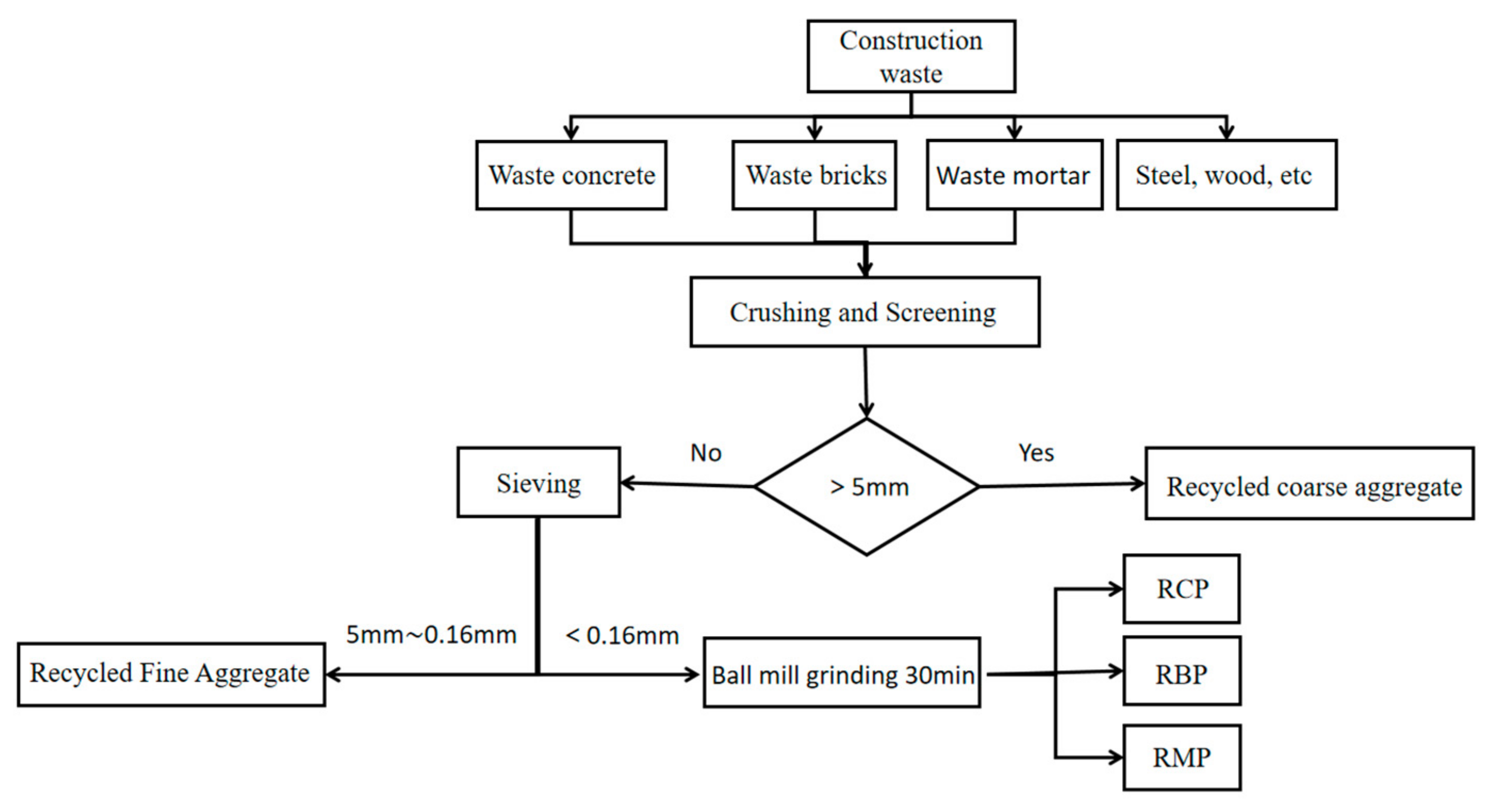
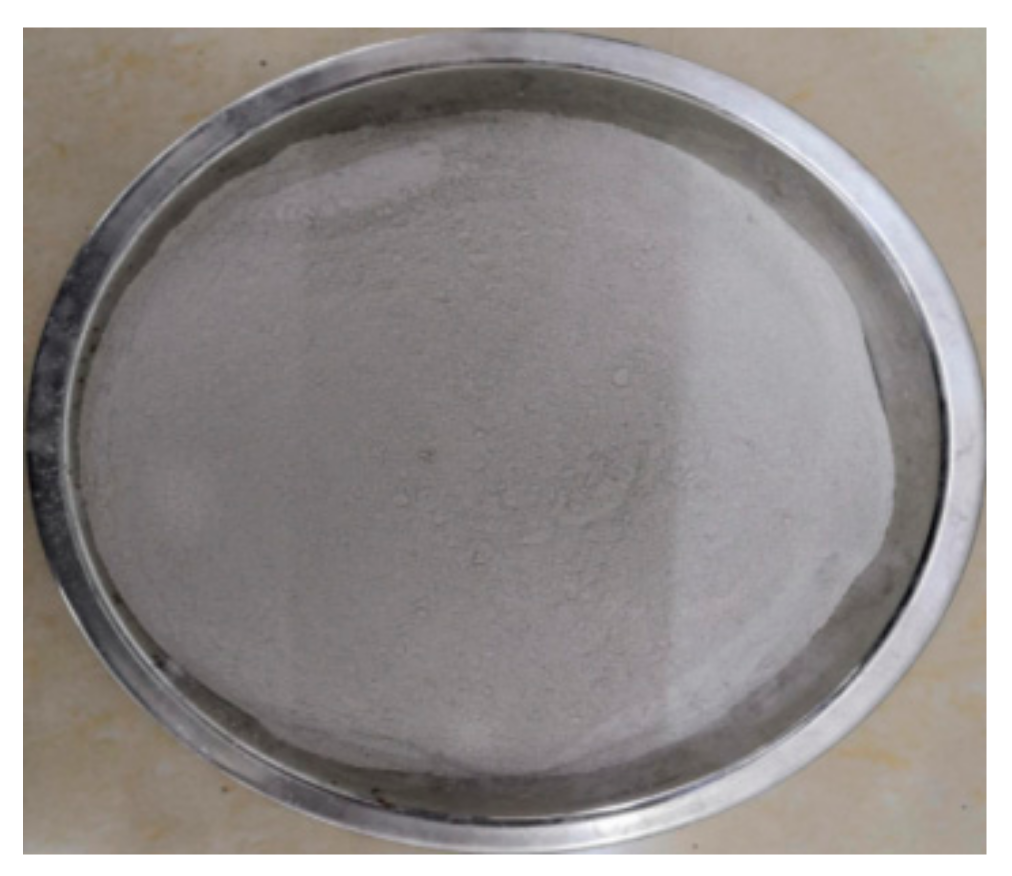
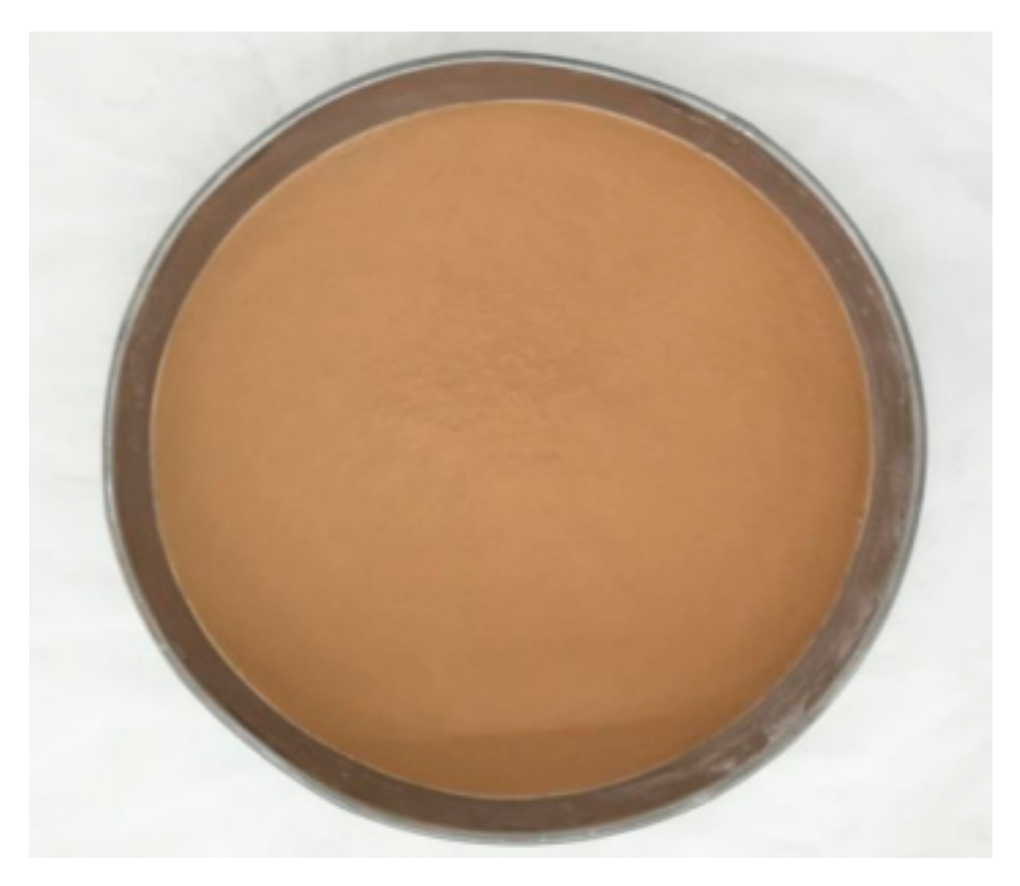


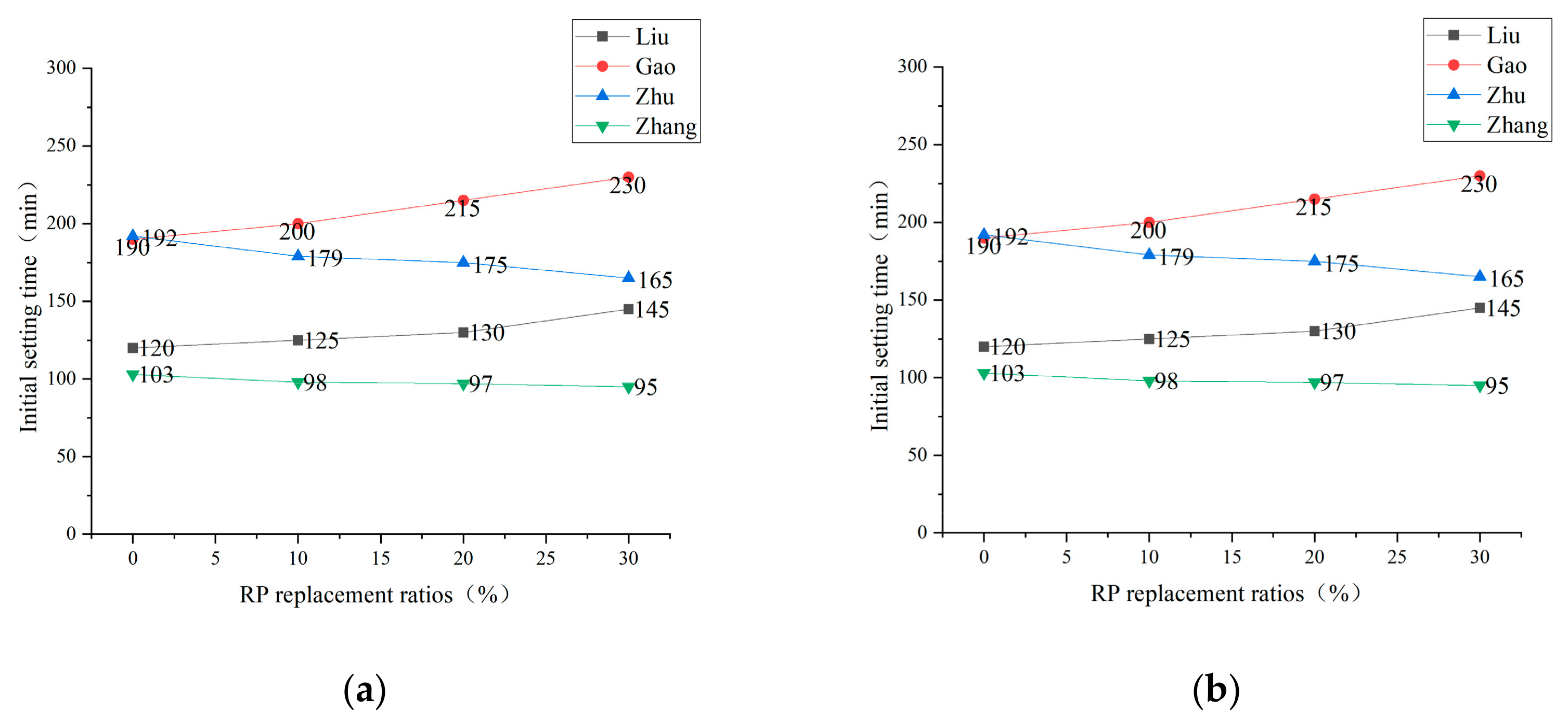
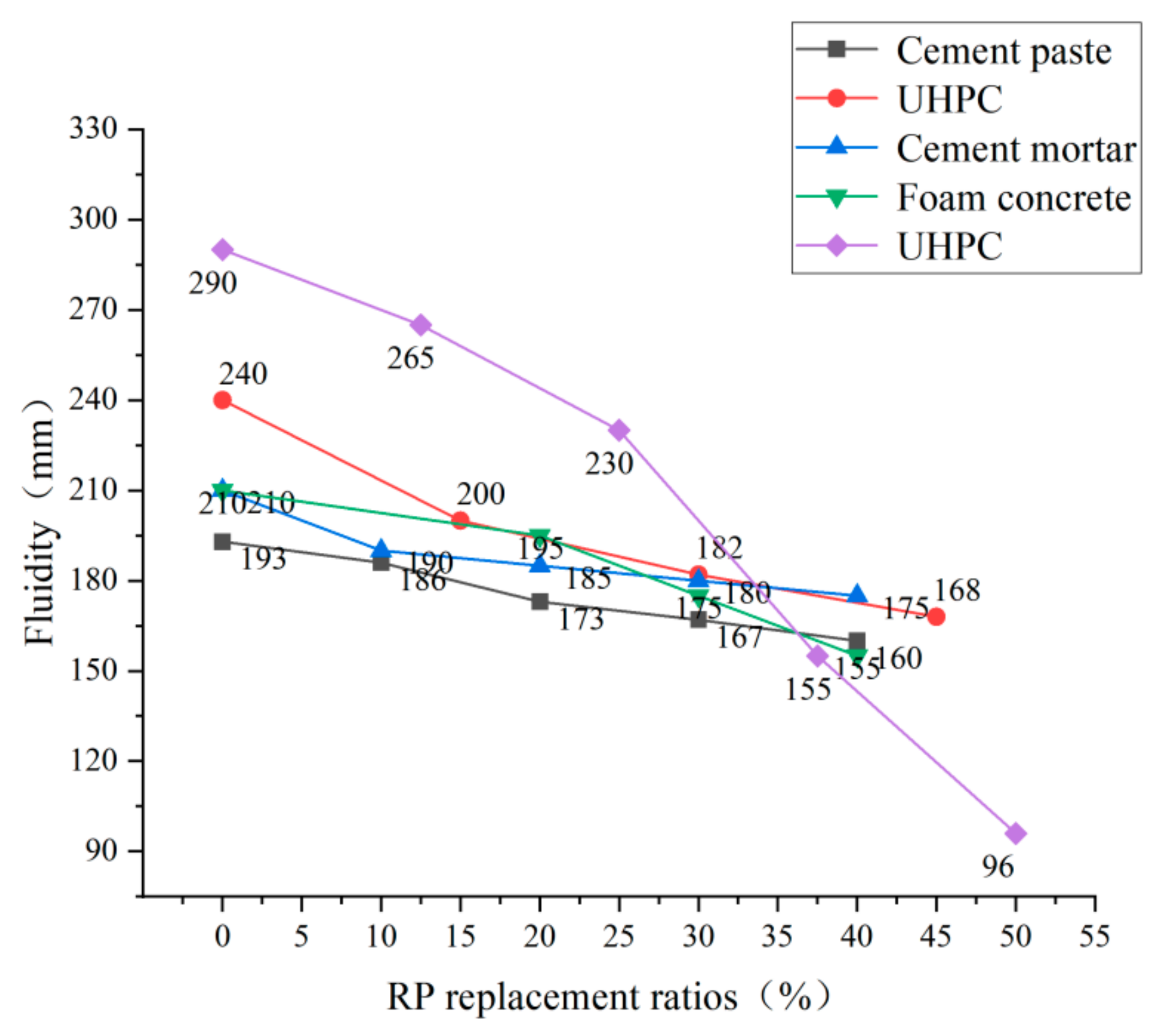
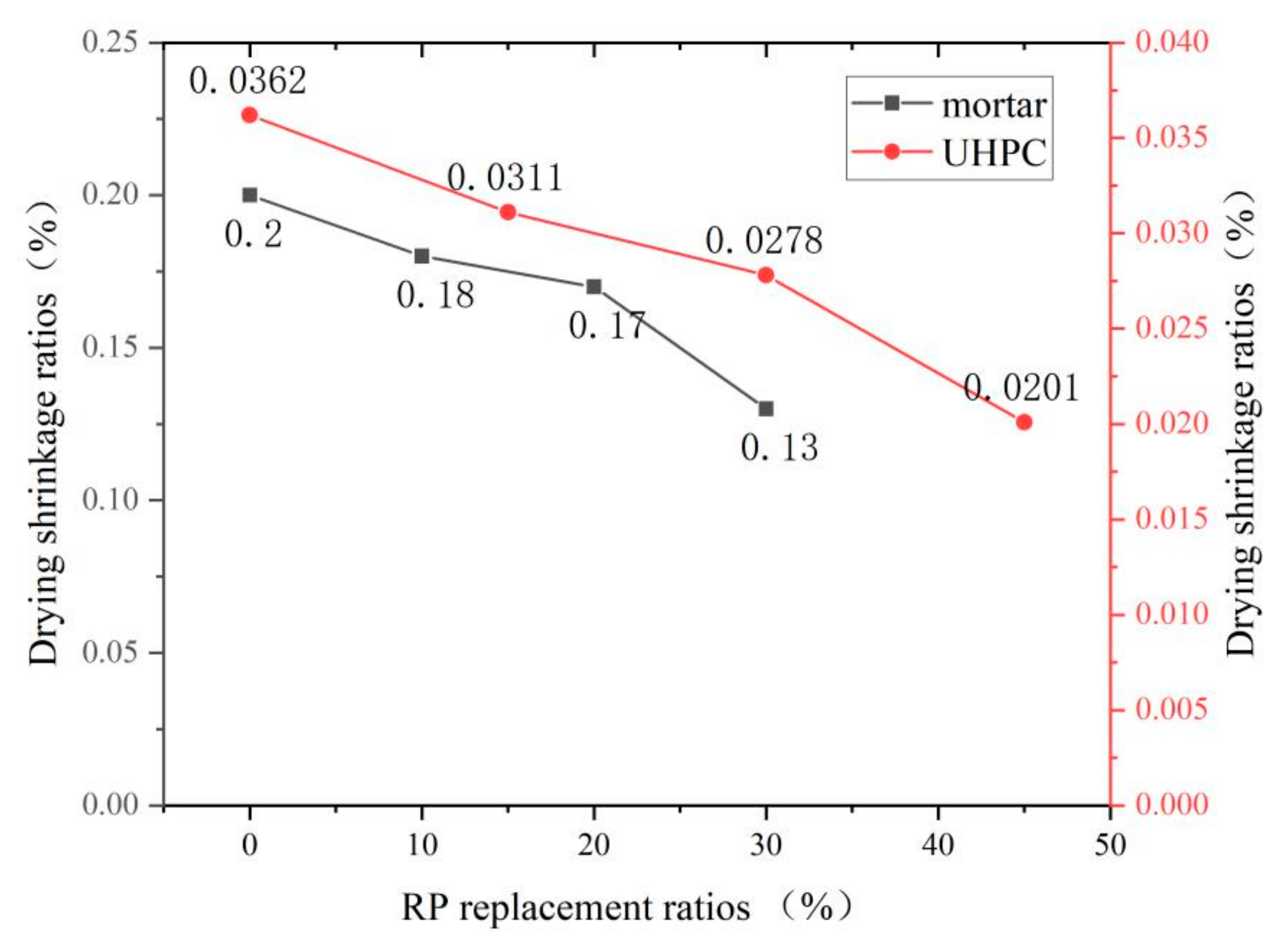

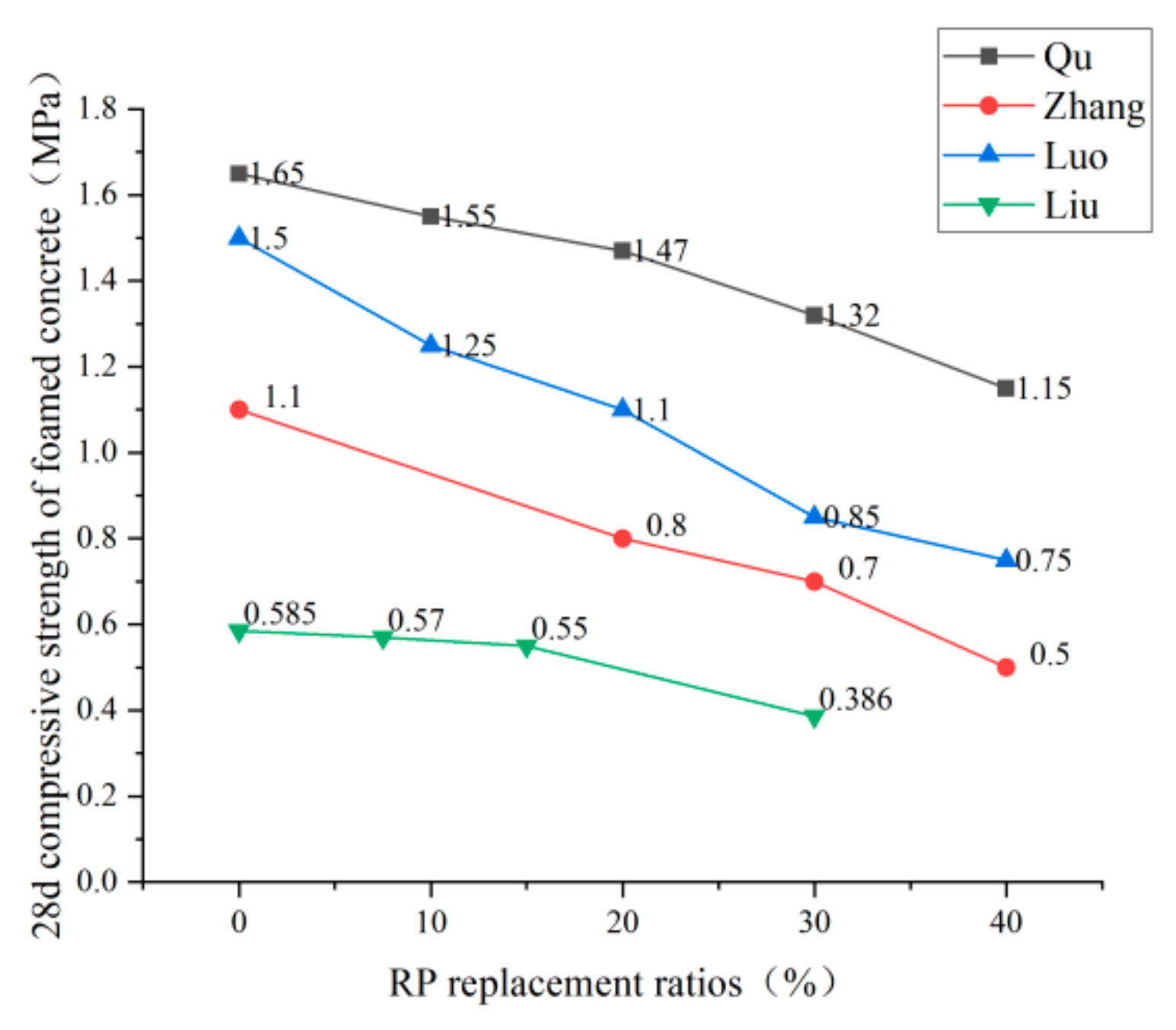
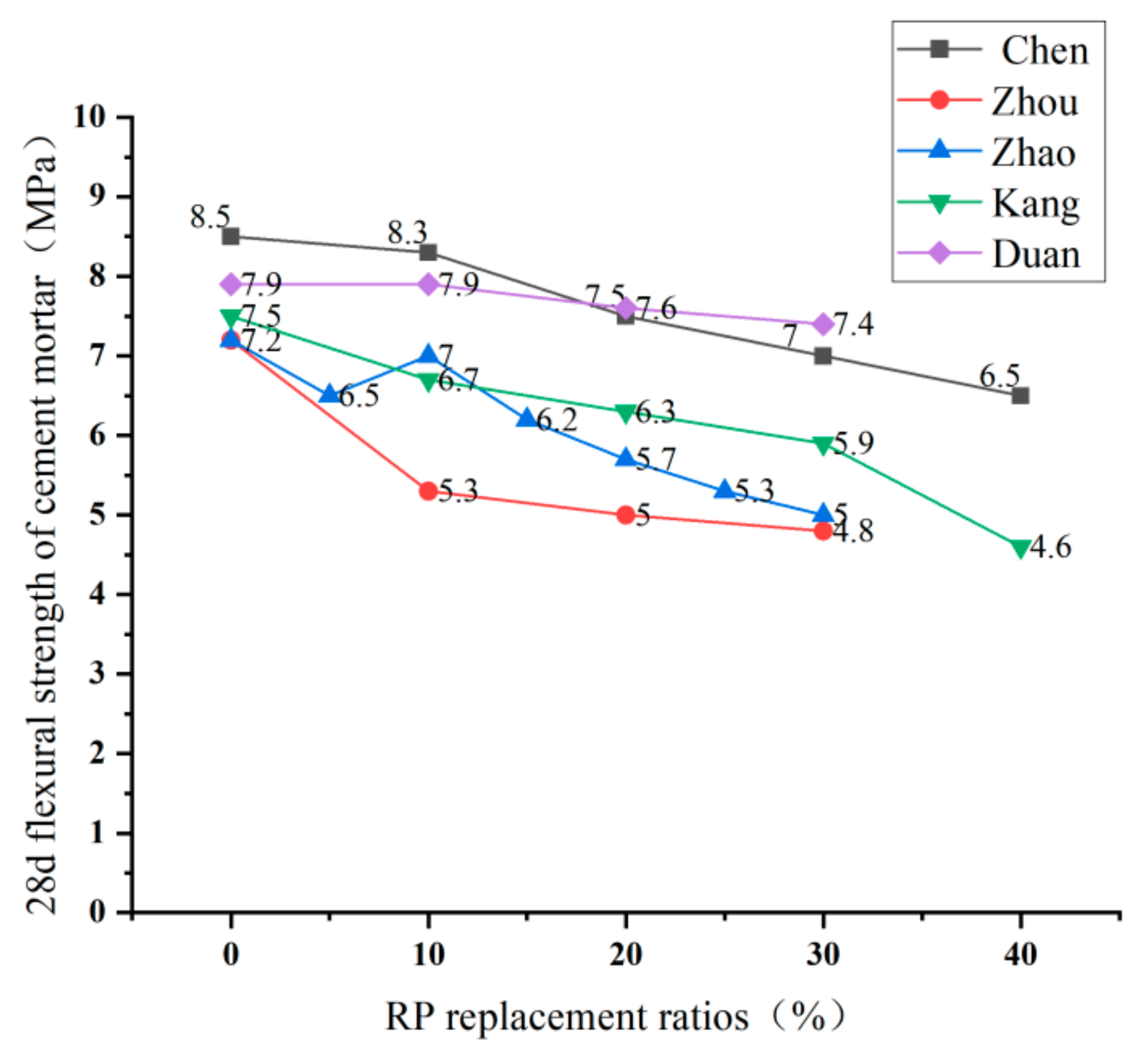
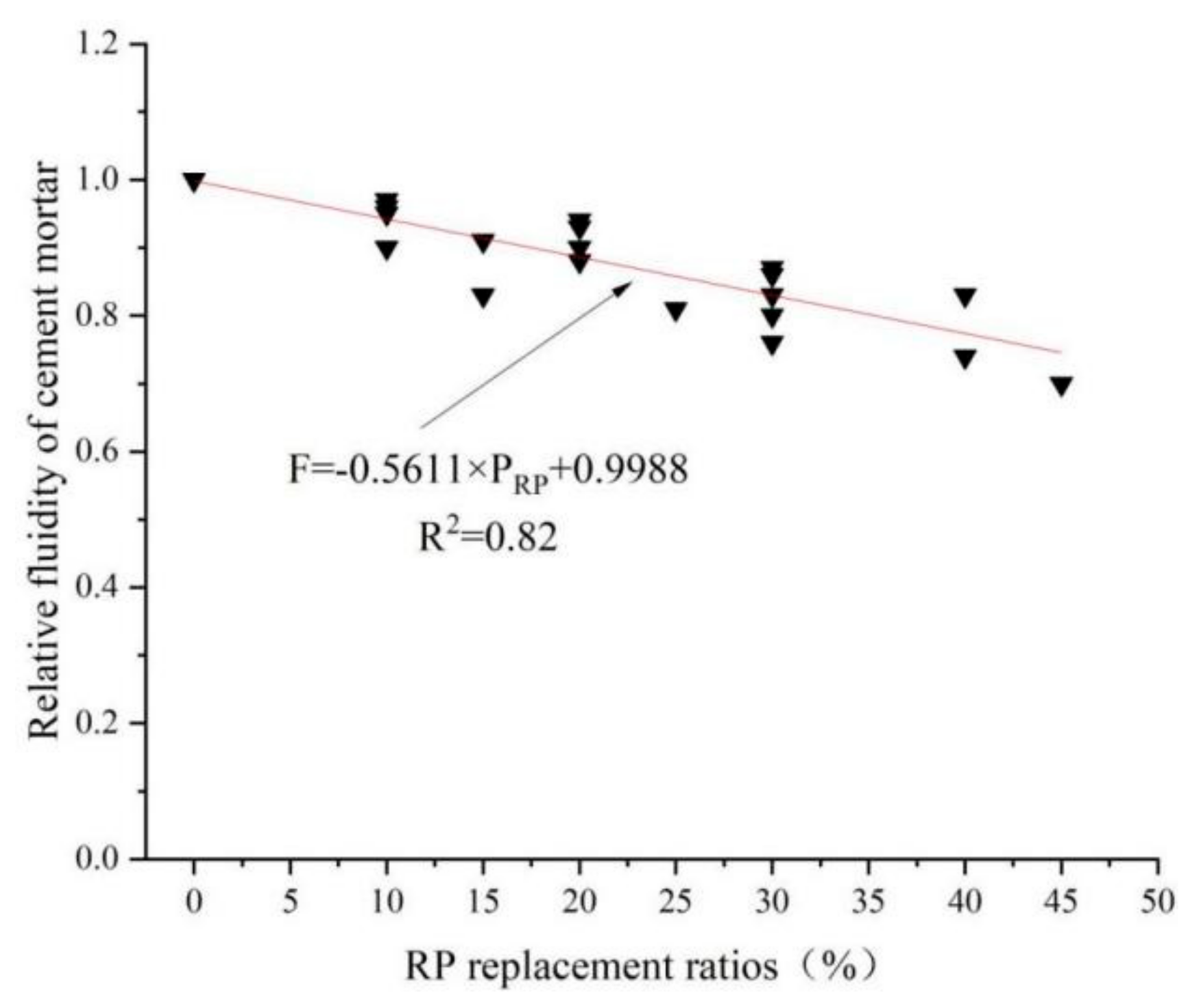
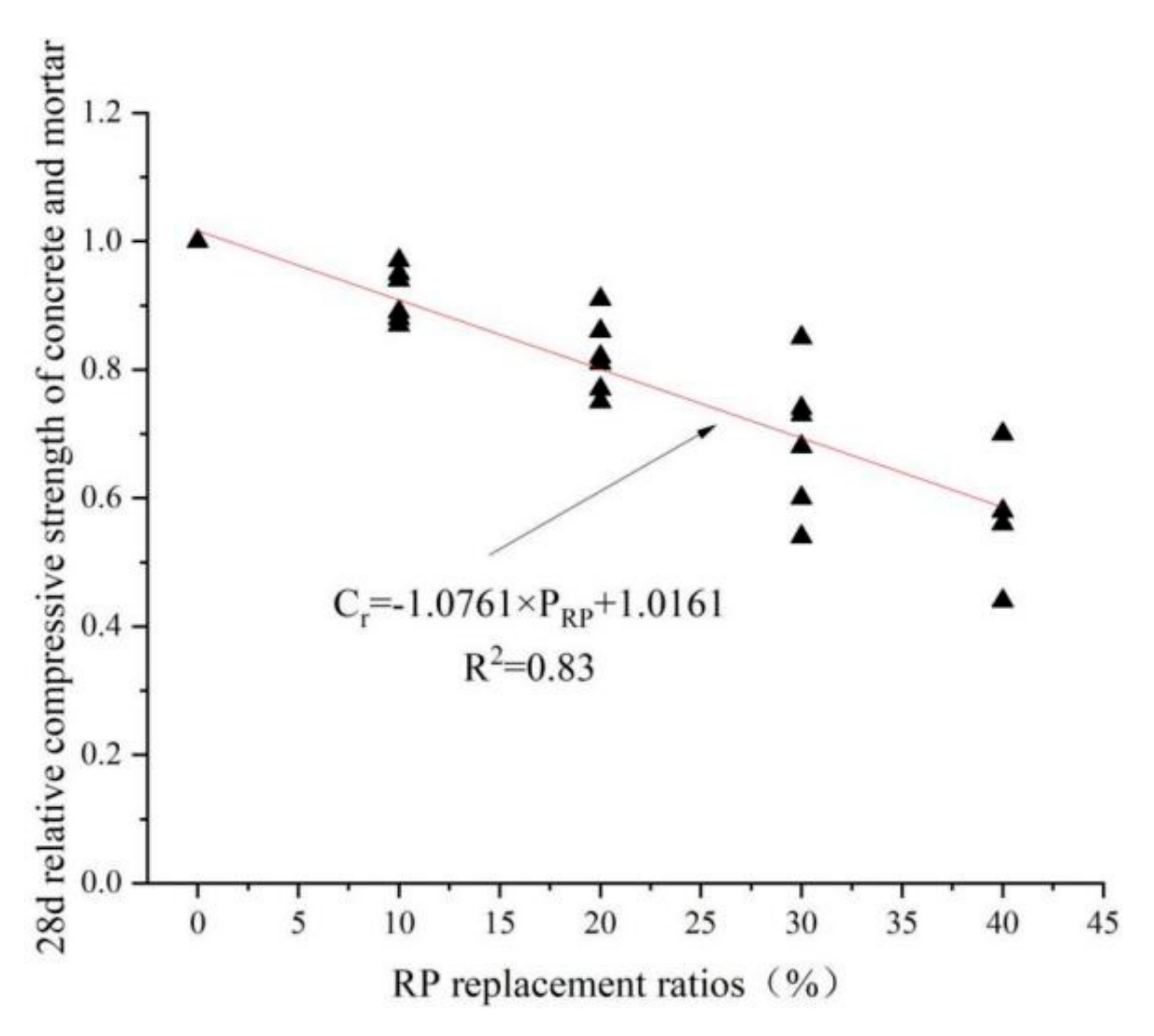
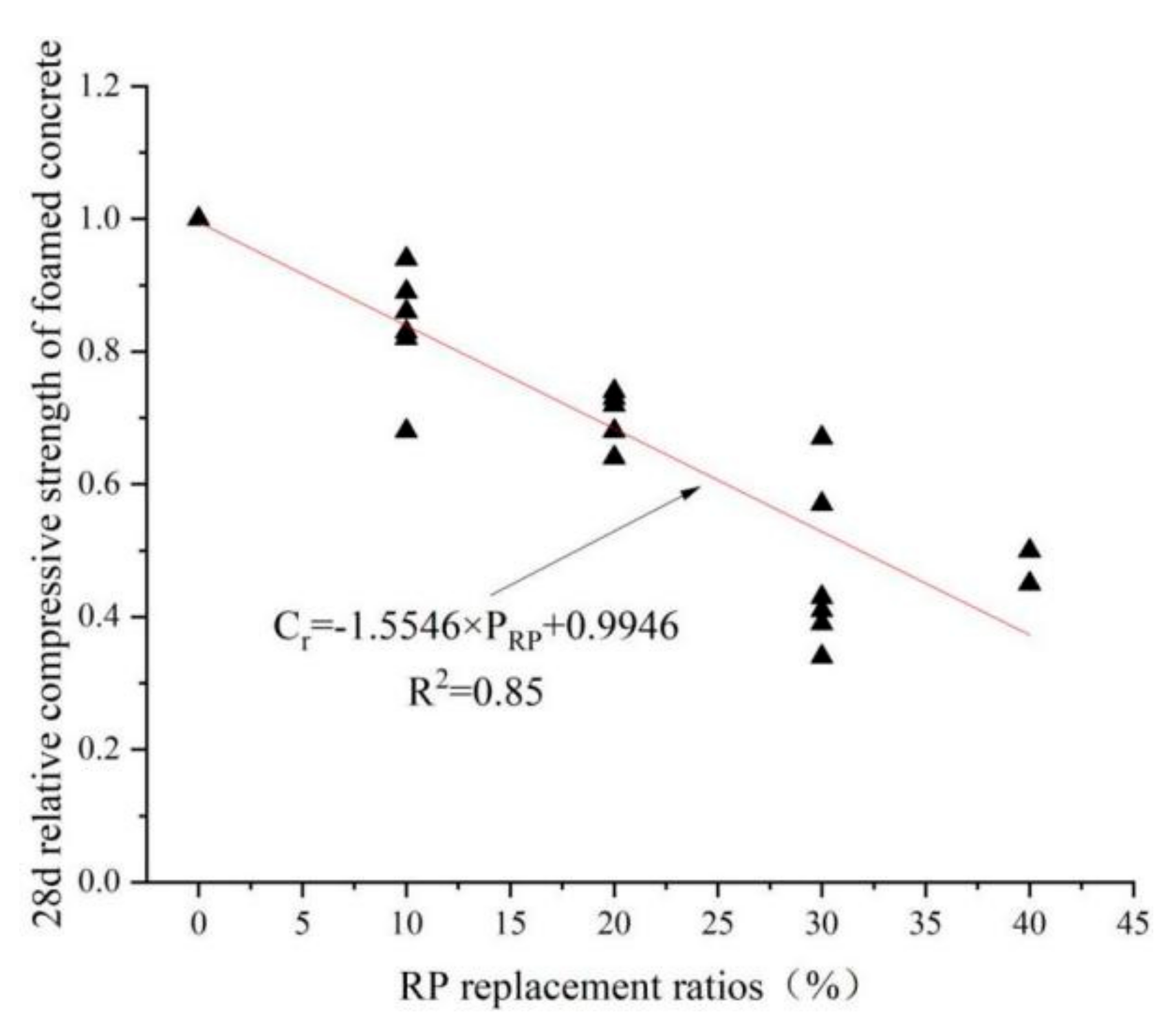

| Average Particle Size (μm) | Apparent Density (kg/m3) | Specific Surface Area (m2/kg) | Bulk Density (kg/m3) |
|---|---|---|---|
| 30~50 | 2300~2700 | 300~700 | 870~920 |
| SiO2 | CaO | Al2O3 | Fe2O3 | MgO | K2O | Na2O | SO3 | Source | |
|---|---|---|---|---|---|---|---|---|---|
| RCP | 50.93 | 18.18 | 13.55 | 6.37 | 2.75 | 3.50 | 2.45 | 0.92 | [46] |
| RBP | 60.56 | 10.07 | 17.16 | 3.46 | 1.78 | 2.50 | 1.26 | 0.34 | [46] |
| RMP | 56.64 | 17.41 | 10.54 | 5.59 | 1.24 | 3.53 | 3.02 | 0.92 | [46] |
| RCP | 62.18 | 10.24 | 10.15 | 2.49 | 1.91 | 1.73 | 1.30 | 0.47 | |
| RBP | 63.12 | 8.52 | 12.29 | 2.68 | 1.33 | 2.02 | 1.74 | 0.37 | |
| RCP | 48.25 | 27.55 | 11.09 | 4.94 | 2.42 | 2.25 | 1.20 | [47] | |
| RBP | 67.83 | 1.67 | 16.20 | 7.55 | 0.94 | [48] | |||
| RP | 63.1 | 10.2 | 10.3 | 2.5 | 1.9 | 1.8 | 1.4 | 0.5 | [32] |
| RP | 47.9 | 18.7 | 12.0 | 6.53 | 2.26 | 2.33 | 0.86 | 1.41 | [22] |
| RP Replacement Ratios (%) —Data (Top–Down: mm; MPa; MPa; MPa) | Regression Equation (After Relativization) | Source | |
|---|---|---|---|
| the fluidity of cement mortar | 0–193; 10–186; 20–173; 30–167; 40–160 | [44] | |
| 0–230; 10–219; 20–216; 30–184 | [47] | ||
| 0–210; 10–190; 20–185; 30–180; 40–175 | [52] | ||
| 0–240; 15–200; 30–182; 45–168 | [67] | ||
| 0–210; 20–195; 30–175; 40–155 | [68] | ||
| 0–210; 10–203; 15–191; 20–190; 25–187; 30–184 | [76] | ||
| the 28 d compressive strength of concrete and mortar | 0–39.2; 10–34; 20–31.7; 30–28.5 | [48] | |
| 0–39; 10–37; 20–32; 30–29 | [76] | ||
| 0–34; 10–33; 20–31; 30–29 | [77] | ||
| 0–50.5; 10–47.5; 20–37.5; 30–27.5; 40–22 | [89] | ||
| 0–65; 10–58; 20–50; 30–39; 40–38 | [95] | ||
| 0–49.3; 10–43.6; 20–42.5; 30–33.6; 40–27.8 | [58] | ||
| the 28 d compressive strength of foam concrete | 0–1.12; 10–1.0; 20–0.83; 30–0.46 0–0.64; 10–0.55; 20–0.46; 30–0.43 0–1.11; 10–0.76; 20–0.71; 30–0.48 0–1.09; 10–0.89; 20–0.74; 30–0.42 | [46] | |
| 0–1.1; 20–0.8; 30–0.7; 40–0.5 | [76] | ||
| 0–1.65; 10–1.55; 20–1.47; 30–1.32; 40–1.15 | [72] | ||
| 0–1.5; 10–1.25; 20–1.1; 30–0.85; 40–0.75 | [78] | ||
| the 28 d flexural strength of cement mortar | 0–7.2; 5–6.5; 10–7; 15–6.2; 20–5.7; 25–5.3; 30–5 | [4] | |
| 0–7.8; 10–6.7; 20–6.3; 30–5.3 | [36] | ||
| 0–8.5; 10–8.3; 20–7.5; 30–7; 40–6.5 | [52] | ||
| 0–6.2; 10–5.4; 15–5.3; 20–5.0; 25–4.9; 30–4.7 | [76] | ||
| 0–7.5; 10–6.7; 20–6.3; 30–5.9; 40–4.6 | [89] | ||
| 0–8.8; 10–8.3; 20–7.5; 30–6.7; 40–6.5 | [96] | ||
| 0–3.75; 5–3.5; 10–3.28; 20–3.11 | [97] |
| Independent Variable | Dependent Variable | Standardized Regression Coefficients | Significance |
|---|---|---|---|
| RP content | relative fluidity of cement mortar | −0.907 | 1.8107 × 10−10 |
| 28 d relative compressive strength of concrete and mortar | −0.914 | 1.8161 × 10−12 | |
| 28 d relative compressive strength of foamed concrete | −0.924 | 1.6625 × 10−11 | |
| 28 d relative flexural strength of cement mortar | −0.917 | 3.7291 × 10−15 |
| RP Content (%) | Relative Fluidity of Cement Mortar | 28 d Relative Compressive Strength of Concrete and Mortar | 28 d Relative Compressive Strength of Foamed Concrete | 28 d Relative Flexural Strength of Cement Mortar |
|---|---|---|---|---|
| 0 | 1 | 1 | 1 | 1 |
| 10 | 0.97 | 0.97 | 0.94 | 0.98 |
| 20 | 0.91 | 0.91 | 0.74 | 0.88 |
| 30 | 0.87 | 0.85 | 0.67 | 0.82 |
| 40 | 0.83 | 0.7 | 0.5 | 0.76 |
| Relative Fluidity of Cement Mortar | 28 d Relative Compressive Strength of Concrete and Mortar | 28 d Relative Compressive Strength of Foamed Concrete | 28 d Relative Flexural Strength of Cement Mortar |
|---|---|---|---|
| 0.40 | 0.40 | 0.40 | 0.40 |
| 0.44 | 0.44 | 0.45 | 0.44 |
| 0.50 | 0.50 | 0.58 | 0.51 |
| 0.56 | 0.57 | 0.69 | 0.59 |
| 0.65 | 0.75 | 1 | 0.70 |
| Evaluation Items | 28 d Relative Compressive Strength of Foamed Concrete | 28 d Relative Compressive Strength of Concrete and Mortar | 28 d Relative Flexural Strength of Cement Mortar | Relative Fluidity of Cement Mortar |
|---|---|---|---|---|
| Grey relational degree | 0.623 | 0.531 | 0.526 | 0.508 |
| Ranking | 1 | 2 | 3 | 4 |
Publisher’s Note: MDPI stays neutral with regard to jurisdictional claims in published maps and institutional affiliations. |
© 2022 by the authors. Licensee MDPI, Basel, Switzerland. This article is an open access article distributed under the terms and conditions of the Creative Commons Attribution (CC BY) license (https://creativecommons.org/licenses/by/4.0/).
Share and Cite
Ji, Y.; Ji, W.; Li, W. Performance of Building Solid Waste Powder in Cement Cementitious Material: A Review. Materials 2022, 15, 5408. https://doi.org/10.3390/ma15155408
Ji Y, Ji W, Li W. Performance of Building Solid Waste Powder in Cement Cementitious Material: A Review. Materials. 2022; 15(15):5408. https://doi.org/10.3390/ma15155408
Chicago/Turabian StyleJi, Yongcheng, Wenhao Ji, and Wei Li. 2022. "Performance of Building Solid Waste Powder in Cement Cementitious Material: A Review" Materials 15, no. 15: 5408. https://doi.org/10.3390/ma15155408
APA StyleJi, Y., Ji, W., & Li, W. (2022). Performance of Building Solid Waste Powder in Cement Cementitious Material: A Review. Materials, 15(15), 5408. https://doi.org/10.3390/ma15155408





